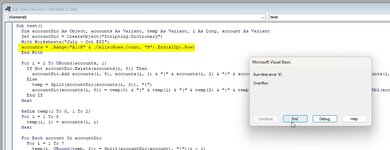2Ruff4U
New Member
- Joined
- May 27, 2004
- Messages
- 31
- Office Version
- 365
- Platform
- Windows
Hello, I have a range of data that has, among other things, sales in a transaction and an Account ID. I am trying to keep this list with the same column headings but if there are duplicates in the Account ID (because that account had more than one transaction) I want to keep the column headings, just keep the one Account ID with the sum total of all the instances of that Account ID and remove the duplicates. The result will be a list with the same column headings, unique Account IDs and the total for all transactions if there is more than one for that Account ID. I tried Subtotals but I lose the column heading and a Pivot Table doesn't seem to keep them either.
Thank you
Thank you







